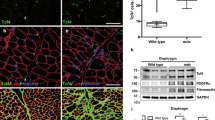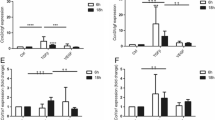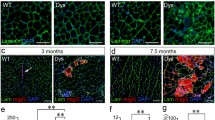Abstract
To probe pro-fibrotic mechanisms in dystrophic muscle, we isolated primary fibroblasts from Duchenne muscular dystrophy (DMD) and control muscle biopsies and induced transdifferentiation in myofibroblasts by transforming growth factor β1 (TGF-β1) treatment. We compared proliferating activity, soluble collagen production, and transcript and protein levels of decorin, myostatin, TGF-β1, matrix metalloproteinase-1 (MMP-1; interstitial collagenase), MMP-2 (gelatinase), MMP-3 (stromelysin), MMP-7 (matrilysin), and the tissue inhibitors of metalloproteinases inhibitors (TIMPs) 1–4, in fibroblasts and myofibroblasts. Principal differences included a significantly greater proliferation rate and soluble collagen production, a significant upregulation of decorin, myostatin and MMP-7 transcripts and proteins, and a significant downregulation of MMP-1 and TIMP-3 transcripts (with MMP-1 protein being reduced as shown by enzyme-linked immunosorbent assay and TIMP-3 protein apparently being reduced on Western blot), in untreated DMD fibroblasts compared with controls. TGF-β1 transdifferentiation significantly lowered decorin and myostatin and significantly increased TGF-β1 transcript and protein, significantly increased MMP-1 and TIMP-3, and significantly lowered MMP-7 transcript and protein in DMD cells compared with pretreatment controls. The differences between DMD and control fibroblasts showed that DMD fibroblasts had a profibrotic phenotype, accentuated by TGF-β1 treatment. Dystrophin absence itself could exert a direct influence on the homeostasis of the extracellular matrix (ECM) by allowing leakage of cellular components to the extracellular space or by abnormal cellular uptake of extracellular growth factors, cytokines, or enzymes influencing muscle fibroblasts either directly by altering adhesion properties or indirectly by interactions with molecules released into the ECM by muscle or inflammatory cells. The transdifferentiation of muscle fibroblasts might serve as a simplified model of fibrosis for further elucidation of the mechanisms of muscle fibrosis and for testing possible anti-fibrotic agents.








Similar content being viewed by others
Abbreviations
- ECM:
-
Extracellular matrix
- DMD:
-
Duchenne muscular dystrophy
- α-SMA:
-
α-Smooth muscle actin
- MMPs:
-
Matrix metalloproteinases
- TIMPs:
-
Tissue inhibitors of metalloproteinases
- TGF-β1:
-
Transforming growth factor β1
References
Ahonen M, Baker AH, Kähäri VM (1998) Adenovirus-mediated gene delivery of tissue inhibitor of metalloproteinases-3 inhibits invasion and induces apoptosis in melanoma cells. Cancer Res 58:2310–2315
Amour A, Slocombe PM, Webster A, Butler M, Knight CG, Smith BJ, Stephens PE, Shelley C, Hutton M, Knäuper V, Docherty AJ, Murphy G (1998) TNF-alpha converting enzyme (TACE) is inhibited by TIMP-3. FEBS Lett 435:39–44
Baker AH, Zaltsman AB, George SJ, Newby AC (1998) Divergent effects of tissue inhibitor of metalloproteinase-1, −2, or −3 overexpression on rat vascular smooth muscle cell invasion, proliferation, and death in vitro. TIMP-3 promotes apoptosis. J Clin Invest 101:1478–1487
Bernasconi P, Torchiana E, Confalonieri P, Brugnoni R, Barresi R, Mora M, Cornelio F, Morandi L, Mantegazza R (1995) Expression of transforming growth-factor beta 1 in dystrophic patient muscles correlates with fibrosis. J Clin Invest 96:1137–1144
Blake DJ, Weir A, Newey SE, Davies KE (2002) Function and genetics of dystrophin and dystrophin-related proteins in muscle. Physiol Rev 82:291–329
Border WA, Ruoslahti E (1992) Transforming growth factor-beta in disease: the dark side of tissue repair. J Clin Invest 90:1–7
Brinckerhoff CE, Ruby PL, Austin SD, Fini ME, White HD (1987) Molecular cloning of human synovial cell collagenase and selection of a single gene from genomic DNA. J Clin Invest 79:542–546
Chang HY, Chi JT, Dudoit S, Bondre C, M van de Rijn, Botstein D, Brown PO (2002) Diversity, topographic differentiation, and positional memory in human fibroblasts. Proc Natl Acad Sci USA 99:12877–12882
De Luca A, Santra M, Baldi A, Giordano A, Iozzo RV (1996) Decorin-induced growth suppression is associated with up-regulation of p21, an inhibitor of cyclin-dependent kinases. J Biol Chem 271:18961–18965
Desmoulière A, Geinoz A, Gabbiani F, Gabbiani G (1993) Transforming growth factor-β1 induces α-smooth muscle actin expression in granulation tissue myofibroblasts and in quiescent and growing cultured fibroblasts. J Cell Biol 122:103–111
Desmoulière A, Redard M, Darby I, Gabbiani G (1995) Apoptosis mediates the decrease in cellularity during the transition between granulation tissue and scar. Am J Pathol 146:56–66
Desmoulière A, Chaponnier C, Gabbiani G (2005) Tissue repair, contraction, and the myofibroblast. Wound Repair Regen 13:7–12
Dickson G, Gower HJ, Barton CH, Prentice HM, Elsom VL, Moore SE, Cox RD, Quinn C, Putt W, Walsh FS (1987) Human muscle neural cell adhesion molecule (N-CAM): identification of a muscle-specific sequence in the extracellular domain. Cell 50:1119–1130
Eckes B, Zigrino P, Kessler D, Holtkötter O, Shephard P, Mauch C, Krieg T (2000) Fibroblast-matrix interactions in wound healing and fibrosis. Matrix Biol 19:325–332
Fadic R, Mezzano V, Alvarez K, Cabrera D, Holmgren J, Brandan E (2006) Increase in decorin and biglycan in Duchenne muscular dystrophy: role of fibroblasts as cell source of these proteoglycans in the disease. J Cell Mol Med 10:758–769
Finlay GA, Thannickal VJ, Fanburg BL, Paulson KE (2000) Transforming growth factor-beta 1-induced activation of the ERK pathway/activator protein-1 in human lung fibroblasts requires the autocrine induction of basic fibroblast growth factor. J Biol Chem 275:27650–27656
Gabbiani G (2003) The myofibroblast in wound healing and fibrocontractive diseases. J Pathol 200:500–503
Gharaee-Kermani M, Hu B, Phan SH, Gyetko MR (2009) Recent advances in molecular targets and treatment of idiopathic pulmonary fibrosis: focus on TGFbeta signaling and the myofibroblast. Curr Med Chem 16:1400–1417
Heino J, Ignotz RA, Hemler ME, Crouse C, Massagué J (1989) Regulation of cell adhesion receptors by transforming growth factor-beta. Concomitant regulation of integrins that share a common beta 1 subunit. J Biol Chem 264:380–388
Herpel E, Pritsch M, Koch A, Dengler TJ, Schirmacher P, Schnabel PA (2006) Interstitial fibrosis in the heart: differences in extracellular matrix proteins and matrix metalloproteinases in end-stage dilated, ischaemic and valvular cardiomyopathy. Histopathology 48:736–747
Hildebrand A, Romaris M, Rasmussen LM, Heinegard D, Twardzik DR, Border WA, Ruoslahti E (1994) Interaction of the small interstitial proteoglycans biglycan, decorin and fibromodulin with transforming growth factor beta. Biochem J 302:527–534
Huang CC, Chuang JH, Chou MH, Wu CL, Chen CM, Wang CC, Chen YS, Chen CL, Tai MH (2005) Matrilysin (MMP-7) is a major matrix metalloproteinase upregulated in biliary atresia-associated liver fibrosis. Mod Pathol 18:941–950
Ignotz RA, Massagué J (1986) Transforming growth factor-beta stimulates the expression of fibronectin and collagen and their incorporation into the extracellular matrix. J Biol Chem 261:4337–4345
Iozzo RV (1999) The biology of the small leucine-rich proteoglycans. Functional network of interactive proteins. J Biol Chem 274:18843–18846
Iredale JP (2007) Models of liver fibrosis: exploring the dynamic nature of inflammation and repair in a solid organ. J Clin Invest 117:539–548
Jordana M, Schulman J, McSharry C, Irving LB, Newhouse MT, Jordana G, Gauldie J (1988) Heterogeneous proliferative characteristics of human adult lung fibroblast lines and clonally derived fibroblasts from control and fibrotic tissue. Am Rev Respir Dis 137:579–584
Kaar JL, Li Y, Blair HC, Asche G, Koepsel RR, Huard J, Russell AJ (2008) Matrix metalloproteinase-1 treatment of muscle fibrosis. Acta Biomater 4:1411–1420
Kissin EY, Lemairem R, Kornm JH, Lafyatis R (2002) Transforming growth factor beta induces fibroblast fibrillin-1 matrix formation. Arthritis Rheum 46:3000–3009
Kossakowska AE, Edwards DR, Lee SS, Urbanski LS, Stabbler AL, Zhang CL, Phillips BW, Zhang Y, Urbanski SJ (1998) Altered balance between matrix metalloproteinases and their inhibitors in experimental biliary fibrosis. Am J Pathol 153:1895–1902
Kuroda K, Shinkai H (1997) Gene expression of types I and III collagen, decorin, matrix metalloproteinases and tissue inhibitors of metalloproteinases in skin fibroblasts from patients with systemic sclerosis. Arch Dermatol Res 289:567–572
Le Bousse-Kerdilès MC, Martyré MC, Samson M (2008) Cellular and molecular mechanisms underlying bone marrow and liver fibrosis: a review. Eur Cytokine Netw 19:69–80
Li YY, Feng YQ, Kadokami T, McTiernan CF, Draviam R, Watkins SC, Feldman AM (2000) Myocardial extracellular matrix remodeling in transgenic mice overexpressing tumor necrosis factor alpha can be modulated by anti-tumor necrosis factor alpha therapy. Proc Natl Acad Sci USA 97:12746–12751
Li ZB, Kollias HD, Wagner KR (2008) Myostatin directly regulates skeletal muscle fibrosis. J Biol Chem 283:19371–19378
Liu X, Wu H, Byrne M, Jeffrey J, Krane S, Jaenisch R (1995) A targeted mutation at the known collagenase cleavage site in mouse type I collagen impairs tissue remodeling. J Cell Biol 130:227–237
Lorena D, Uchio K, Costa AM, Desmoulière A (2002) Normal scarring: importance of myofibroblasts. Wound Repair Regen 10:86–92
Matsumura K, Campbell KP (1994) Dystrophin-glycoprotein complex: its role in the molecular pathogenesis of muscular dystrophies. Muscle Nerve 17:2–15
Mauviel A (2005) Transforming growth factor-beta: a key mediator of fibrosis. Methods Mol Med 117:69–80
McPherron AC, Lee SJ (1997) Double muscling in cattle due to mutations in the myostatin gene. Proc Natl Acad Sci USA 94:12457–12461
Milani S, Herbst H, Schuppan D, Kim KY, Riecken EO, Stein H (1990) Procollagen expression by nonparenchymal rat liver cells in experimental biliary fibrosis. Gastroenterology 98:175–184
Miura T, Kishioka Y, Wakamatsu J, Hattori A, Hennebry A, Berry CJ, Sharma M, Kambadur R, Nishimura T (2006) Decorin binds myostatin and modulates its activity to muscle cells. Biochem Biophys Res Commun 340:675–680
Montesano R, Orci L (1988) Transforming growth factor beta stimulates collagen-matrix contraction by fibroblasts: implications for wound healing. Proc Natl Acad Sci USA 85:4894–4897
Pannu J, Gardner H, Shearstone JR, Smith E, Trojanowska M (2006) Increased levels of transforming growth factor beta receptor type I and up-regulation of matrix gene program: a model of scleroderma. Arthritis Rheum 54:3011–3021
Pfaffl MW (2001) A new mathematical model for relative quantification in real-time RT-PCR.Nucleic Acids Res 29:e45
Raghu G, Chen YY, Rusch V, Rabinovitch PS (1988) Differential proliferation of fibroblasts cultured from normal and fibrotic human lungs. Am Rev Respir Dis 138:703–708
Ramos C, Montano M, Garcia-Alvarez J, Ruiz V, Uhal BD, Selman M, Pardo A (2001) Fibroblasts from idiopathic pulmonary fibrosis and normal lungs differ in growth rate, apoptosis, and tissue inhibitor of metalloproteinases expression. Am J Respir Cell Mol Biol 24:591–598
Roberts AB, Sporn MB (1996) Transforming growth factor-β. In: Clark RAF (ed) The molecular and cellular biology of wound repair. Plenum, New York, pp 275–308
Ronnov-Jessen L, Petersen OW (1993) Induction of alpha-smooth muscle actin by transforming growth factor-beta 1 in quiescent human breast gland fibroblasts. Implications for myofibroblast generation in breast neoplasia. Lab Invest 68:696–707
Sappino AP, Masouyé I, Saurat JH, Gabbiani G (1990) Smooth muscle differentiation in scleroderma fibroblastic cells. Am J Pathol 137:585–591
Schmid P, Itin P, Cherry G, Bi C, Cox DA (1998) Enhanced expression of transforming growth factor-beta type I and type II receptors in wound granulation tissue and hypertrophic scar. Am J Pathol 152:485–493
Schnaper HW, Kopp JB, Poncelet AC, Hubchak SC, Stetler-Stevenson WG, Klotman PE, Kleinman HK (1996) Increased expression of extracellular matrix proteins and decreased expression of matrix proteases after serial passage of glomerular mesangial cells. J Cell Sci 109:2521–2528
Selman M, King TE, Pardo A (2001) Idiopathic pulmonary fibrosis: prevailing and evolving hypotheses about its pathogenesis and implications for therapy. Ann Intern Med 134:136–151
Sime PJ, Xing Z, Graham FL, Csaky KG, Gauldie J (1997) Adenovector-mediated gene transfer of active transforming growth factor-beta1 induces prolonged severe fibrosis in rat lung. J Clin Invest 100:768–776
Surendran K, Simon TC, Liapis H, McGuire JK (2004) Matrilysin (MMP-7) expression in renal tubular damage: association with Wnt4. Kidney Int 65:2212–2222
Takeda K, Hatamochi A, Ueki H, Nakata M, Oishi Y (1994) Decreased collagenase expression in cultured systemic sclerosis fibroblasts. J Invest Dermatol 103:359–363
Thannickal VJ, Aldweib KD, Rajan T, Fanburg BL (1998) Upregulated expression of fibroblast growth factor (FGF) receptors by transforming growth factor-beta1 (TGF-beta1) mediates enhanced mitogenic responses to FGFs in cultured human lung fibroblasts. Biochem Biophys Res Commun 251:437–441
Uria JA, Jimenez MG, Balbin M, Freije JMP, Lopez-Otin C (1998) Differential effects of transforming growth factor-beta on the expression of collagenase-1 and collagenase-3 in human fibroblasts. J Biol Chem 273:9769–9777
Vogel KG, Paulsson M, Heinegard D (1984) Specific inhibition of type I and type II collagen fibrillogenesis by the small proteoglycan of tendon. Biochem J 223:587–597
Wells RG (2000) Fibrogenesis V. TGF-β signaling pathways. Am J Physiol Gastrointest Liver Physiol 279:G845–G850
Westergren-Thorsson G, Hernnas J, Sarnstrand B, Oldberg A, Heinegard D, Malmstrom A (1993) Altered expression of small proteoglycans, collagen, and transforming growth factor-beta 1 in developing bleomycin-induced pulmonary fibrosis in rats. J Clin Invest 92:632–637
Westergren-Thorsson G, Sime P, Jordana M, Gauldie J, Sarnstrand B, Malmstrom A (2004) Lung fibroblast clones from normal and fibrotic subjects differ in hyaluronan and decorin production and rate of proliferation. Int J Biochem Cell Biol 36:1573–1584
Yamaguchi Y, Mann DM, Rouslahti E (1990) Negative regulation of transforming growth factor-beta by the proteoglycan decorin. Nature 19:281–284
Yamanouchi K, Soeta C, Naito K, Tojo H (2000) Expression of myostatin gene in regenerating skeletal muscle of the rat and its localization. Biochem Biophys Res Commun 270:510–516
Yu WH, Yu S, Meng Q, Brew K, Woessner JF Jr (2000) TIMP-3 binds to sulfated glycosaminoglycans of the extracellular matrix. J Biol Chem 275:31226–31232
Zanotti S, Negri T, Cappelletti C, Bernasconi P, Canioni E, Di Blasi C, Pegoraro E, Angelini C, Ciscato P, Prelle A, Mantegazza R, Morandi L, Mora M (2005) Decorin and biglycan expression is differentially altered in several muscular dystrophies. Brain 128:2546–2555
Zanotti S, Saredi S, Ruggieri A, Fabbri M, Blasevich F, Romaggi S, Morandi L, Mora M (2007) Altered extracellular matrix transcript expression and protein modulation in primary Duchenne muscular dystrophy myotubes. Matrix Biol 26:615–624
Zhang Z, Li XJ, Liu Y, Zhang X, Li YY, Xu WS (2007) Recombinant human decorin inhibits cell proliferation and downregulates TGF-β1 production in hypertrophic scar fibroblasts. Burns 33:634–641
Zhu J, Li Y, Shen W, Qiao C, Ambrosio F, Lavasani M, Nozaki M, Branca MF, Huard J (2007) Relationships between transforming growth factor-beta1, myostatin, and decorin: implication for skeletal muscle fibrosis. J Biol Chem 282:25852–25863
Zuo F, Kaminski N, Eugui E, Allard J, Yakhini Z, Ben-Dor A, Pollini L, Morris D, Kim Y, DeLustro B, Sheppard D, Pardo A, Selman M, Heller RA (2002) Gene expression analysis reveals matrilysin as a key regulator of pulmonary fibrosis in mice and humans. Proc Natl Acad Sci USA 99:6292–6297
Acknowledgments
The authors are grateful to Professor Renato Iozzo of the Thomas Jefferson University of Philadelphia for helpful suggestions on the detection of the glycosylated form of decorin by Western blot and to Don Ward for help with the English.The EuroBioBank and Telethon Network of Genetic Biobanks (GTB07001F) are also gratefully acknowledged for providing biological samples.
Author information
Authors and Affiliations
Corresponding author
Additional information
The financial support of the Italian Ministry of Health is gratefully acknowledged.
Rights and permissions
About this article
Cite this article
Zanotti, S., Gibertini, S. & Mora, M. Altered production of extra-cellular matrix components by muscle-derived Duchenne muscular dystrophy fibroblasts before and after TGF-β1 treatment. Cell Tissue Res 339, 397–410 (2010). https://doi.org/10.1007/s00441-009-0889-4
Received:
Accepted:
Published:
Issue Date:
DOI: https://doi.org/10.1007/s00441-009-0889-4




